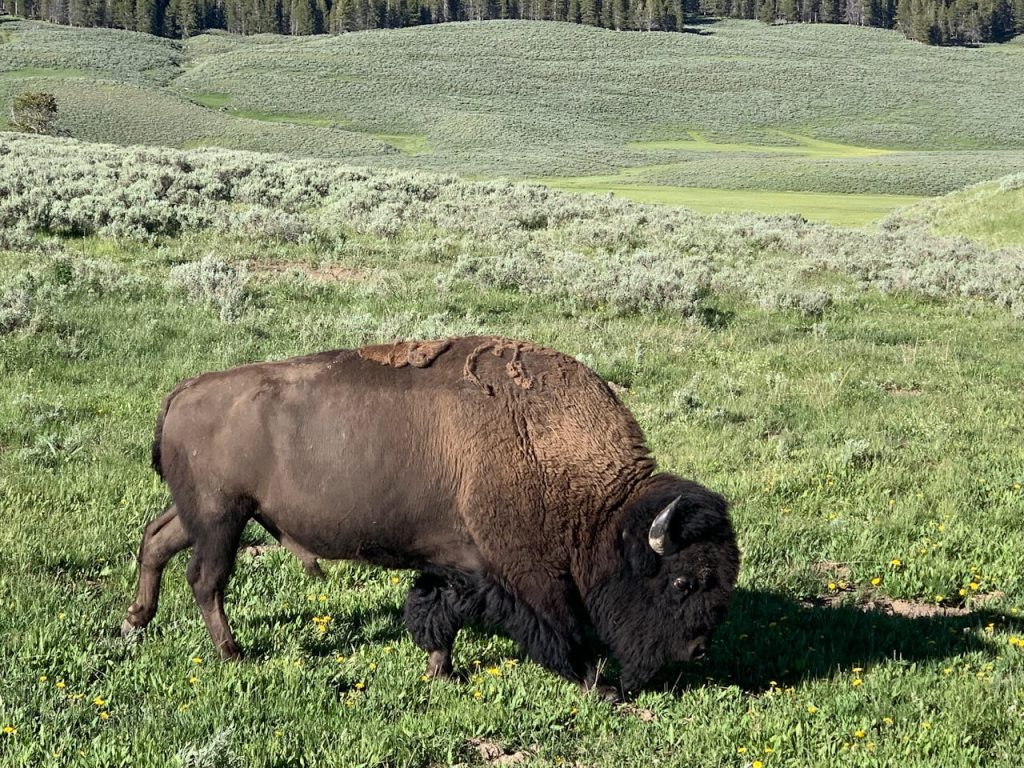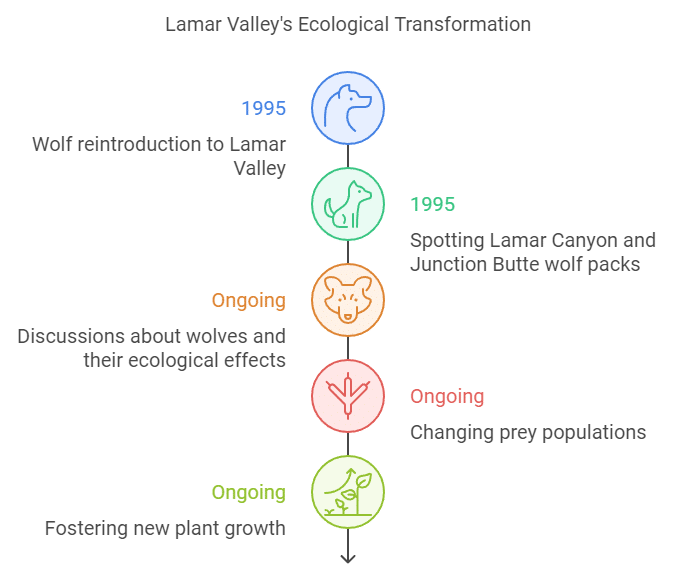
Lamar Valley, often called the “Serengeti of North America,” is within Yellowstone National Park’s breathtaking expanse. This paradise is not just another scenic location—it’s the ultimate destination for witnessing awe-inspiring landscapes and diverse wildlife.
Stepping into Lamar Valley feels like entering a captivating nature documentary, only more immersive. Whether you’re interested in geology, passionate about conservation, or eager to revel in the unspoiled beauty of the natural world, Lamar Valley should be at the top of your travel list.
Listen to a great overview

Indigenous communities cherished its essence long before modern explorers set foot in Lamar Valley. Groups like the Snake Indians thrived in this fertile land for centuries.
Osborne Russell’s journal from 1834 describes the valley as a “Garden of Eden,” capturing early visitors’ admiration for its lush resources. The 1869 Cook–Folsom–Peterson Expedition provided valuable insights into the interactions between early humans and this magnificent valley, documenting its unparalleled natural beauty.
You may be curious about the name of the river Lamar. It commemorates L.Q.C. Lamar, who served as Secretary of the Interior from 1885 to 1888. His legacy is a testament to the early efforts of government leaders in promoting conservation initiatives.
As the late 19th century approached, the conservation movement began gaining traction. Central to these efforts were the iconic bison herds.
The establishment of the Lamar Buffalo Ranch in 1907 aimed to protect these creatures from extinction. This endeavor laid the groundwork for modern conservation practices, emphasizing preserving wildlife.
The stunning landscapes of Lamar Valley owe their origin to ancient glacial activity. The U-shaped valley, sculpted by glaciers, offers a glimpse into Earth’s history.
These monumental ice masses shaped the terrain, leaving remarkable boulders that dot the valley floor. Each tells a unique story of geological transformation. Marshy ponds throughout the area serve as crucial habitats for migrating elk and bison, showcasing the ecosystem’s delicate balance.
The Lamar River originates in the rugged Absaroka Range and is nourished by tributaries such as Soda Butte Creek and Slough Creek. It eventually merges with the Yellowstone River near Tower Junction.
The 1988 wildfires were a powerful reminder of the region’s resilience and vulnerability as ecosystems adapt to changing conditions.
If you enjoy fly fishing, Lamar Valley is an ideal destination. The river is home to a healthy cutthroat trout population, especially during caddisfly and pale morning dun hatches in July. Anglers must adhere to regulations promoting ecological balance, such as removing non-native fish species to maintain the local trout population.

The establishment of the Lamar Buffalo Ranch in 1907 marked a turning point in bison conservation. At the time, bison were nearing extinction.
The ranch implemented proactive measures to protect and revive the dwindling bison population. As a result of these endeavors, the bison population has rebounded from a mere 25 individuals in 1901 to thousands today.
This success story highlights the ranch’s significant contribution to bison conservation and demonstrates the effectiveness of combining historical knowledge with modern conservation techniques.
The Lamar Buffalo Ranch is an educational hub, offering programs through the Yellowstone Forever Institute to inform visitors about conservation and the valley’s ecosystems3.
The reintroduction of bison across public and tribal lands illustrates a successful blend of historical knowledge and modern conservation techniques while addressing contemporary challenges like disease and habitat loss.
On a crisp autumn morning, David and I set out for Lamar Valley, excited to explore Yellowstone’s wildlife haven. As we meandered along the winding road, the golden hues of the grasses contrasted against the deep blue sky. Suddenly, we spotted a herd of bison grazing peacefully by the river. I urged David to be patient and observe them quietly; wildlife encounters are best enjoyed from a distance. As we watched, a majestic wolf appeared on the forest’s edge. I whispered to David how vital every creature is to this ecosystem. Inspired, he said, “Dad, we must protect them.” At that moment, I realized my most incredible adventure was sharing these lessons with him.
In 1995, the wolf’s return to Lamar Valley was a significant step in restoring the natural balance of predator and prey. Spotting the Lamar Canyon and Junction Butte wolf packs epitomizes the impact of this reintroduction.
Ongoing discussions about wolves and their ecological effects continue to shape our understanding of the valley’s dynamics, from changing prey populations to fostering new plant growth.

Lamar Valley is a haven for diverse wildlife, including grizzly bears, elk, and pronghorn antelope. Visitors must adhere to National Park Service guidelines by maintaining a safe distance and avoiding the temptation to feed animals.
Education programs are vital in cultivating a culture of respect and commitment to conservation.

Reaching Lamar Valley is easy, with convenient access points from various Yellowstone entrances and shuttle services.
For prime wildlife-viewing opportunities, plan to visit in the early morning or late evening, when animals are most active. Guided tours enhance the experience by offering profound insights into the valley’s ecology and history.
The Lamar Buffalo Ranch serves as an educational hub, thanks to its programs offered by the Yellowstone Forever Institute. These initiatives aim to enrich visitors’ understanding of conservation and foster a deeper appreciation for the valley’s ecosystems through workshops and field classes.
By adhering to these safety guidelines, visitors can enjoy the wonders of Lamar Valley while ensuring their safety and the well-being of the park’s wildlife.
Sustainability is a core value at the Lamar Buffalo Ranch. They have implemented a 44-kilowatt photovoltaic solar array to improve energy efficiency, complementing their shift towards hybrid battery systems to reduce reliance on fossil fuels.
Historic preservation is paramount as they integrate modern practices while honoring the rich legacy of the Lamar Buffalo Ranch Historic District.
Balancing bison conservation with wolf management poses significant challenges in today’s climate. As landscapes evolve due to climate change, adaptive strategies become essential.
Furthermore, establishing an informed dialogue about predator reintroduction requires a nuanced approach considering ecological, economic, and community perspectives.
Plan your adventure to Lamar Valley today! Immerse yourself in its serene beauty and remember your role in supporting ongoing conservation efforts. Your visit can contribute to preserving this natural wonder and enhancing larger wildlife initiatives.
Q: What wildlife can I expect to see in Lamar Valley at Yellowstone National Park?
A: Lamar Valley is famous for its diverse wildlife, including bison, elk, pronghorn, and various bird species. It’s one of the best spots to see wolves and bears, especially during dawn and dusk when these animals are most active.
Q: What is the best time to visit Lamar Valley in Yellowstone National Park?
A: The ideal times to visit are during spring (April to June) and fall (September to October). These seasons offer the most wildlife activity and breathtaking scenery, with blooming wildflowers in spring and vibrant autumn leaves.
Q: Are there hiking trails in Lamar Valley for visitors to explore?
A: In Lamar Valley, several hiking trails are suitable for varying skill levels. Easy trails provide scenic views and exciting wildlife-watching opportunities, while experienced hikers can enjoy more challenging paths like the Lamar River Trail and Slough Creek Trail.
Q: How do I get to Lamar Valley within Yellowstone National Park?
A: Most visitors enter Yellowstone through the Northeast Entrance to reach Lamar Valley. The valley is accessible via the Grand Loop Road, which offers beautiful views and various pull-offs for wildlife observation along the way.
Q: What safety tips should I remember while visiting Lamar Valley in Yellowstone?
A: Always maintain a safe distance from wildlife—at least 100 yards from bears and wolves and 50 yards from bison and elk. Stay on designated trails, carry bear spray, and remain aware of changing weather conditions.
Citations and References
Yellowstone Country: “Discover Lamar Valley: Yellowstone National Park’s Wildlife Paradise” (URL: https://www.yellowstonecountry.com/blogposts/discover-lamar-valley-yellowstone-national-parks-wildlife-paradise) National Park Service: “Lamar Buffalo Ranch: Birthplace of Wildlife Conservation” (URL: https://www.nps.gov/places/lamar-buffalo-ranch.htm) Best of Yellowstone: “Lamar Valley Yellowstone National Park” (URL: https://www.bestofyellowstone.com/travel-guide/Lamar-Valley/) Wikipedia: “Lamar River” (URL: https://en.wikipedia.org/wiki/LamarRiver) National Parks with T: “Yellowstone National Park: Lamar Valley” (URL: https://nationalparkswitht.com/2024/05/28/yellowstone-national-park-lamar-valley/)


The Montana Style is a participant in the Amazon Services LLC Associates Program, an affiliate advertising program designed to provide a means for sites to earn advertising fees by advertising and linking to Amazon.com
To learn more about Trevor Riggs, please visit our About page.
The Montana Style is a participant in the Amazon Services LLC Associates Program, an affiliate advertising program designed to provide a means for sites to earn advertising fees by advertising and linking to Amazon.com